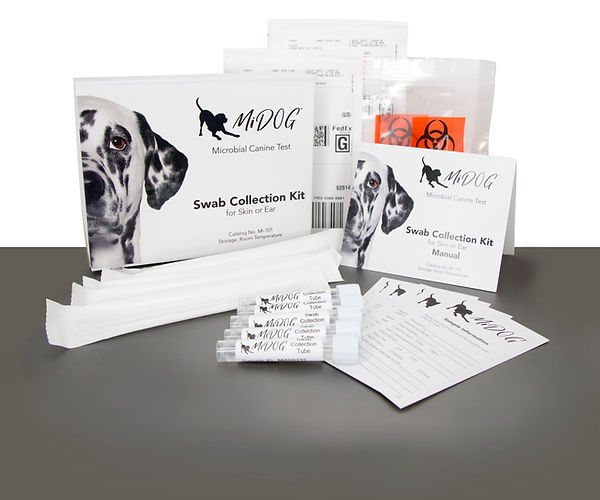
Antibiotic resistance is an increasing global problem, both for public and animal health and welfare. Considering antibiotic resistance is influenced not only by human and animal antibiotic use, but also by intrinsic resistance exhibited by some pathogenic microorganisms, understanding the clinical implications of animal skin microbiomes is becoming increasingly important. With contemporary research employing the use of Next-Gen Sequencing to aptly characterize the skin microbiome of various animals, veterinary medicine is experiencing a rapid transformation in a clinical diagnostic capacity.
In the second part of our interview series, we continue our conversation with Dr. Alissa Rexo, a veterinarian that specializes in dermatology. Dr. Rexo earned her doctorate of veterinary medicine from Atlantic Veterinary College at the University of Prince Edward Island, Canada. In addition to her dermatologic work, she has spent time as a chief medical officer for a start-up animal health company focused on enzyme-based dental and dermatology products. Dr. Rexo is also a certified veterinary acupuncturist through the International Veterinary Acupuncture Society.
The purpose of this two-part interview is to inform clinicians and pet-owners about important dermatologic issues to consider when determining diagnostic and treatment options.
And so without further ado, let’s continue our conversation with Dr. Rexo!

Dr. Rexo sat down with us to talk about her newest research
Alternatively, listen to the second part of the interview here.
Missed part one of the interview? Read the blog here.
Q: And now, moving a little away from the microbiome and to more pet owner-related questions. So just to give our listeners an overview again, what’s the difference specifically between dermatitis and allergies?
Dermatitis is a fairly general term and refers to skin inflammation. It’s a common condition that we see in pets and it often will result in itchy dry skin or even a rash that might develop. Dermatitis is actually caused by self-inflicted trauma from a pet that’s licking or scratching the skin secondary to allergic itch, bacterial, or fungal skin infections that might be present. We often see allergies that can result from environmental or food allergies.
Q: And what causes these allergies?
So, that’s a more complicated question. Dogs can develop both foods as well as an inhalant or environmental allergies. Allergies overall are a damaging immune response that occurs in the body when a substance is present that our body reacts to. One of these presentations that we see in dogs is a condition called atopic dermatitis, and it’s actually a hereditary condition that results in itchy and inflamed skin issues.
It can be associated with a protein in the body or an immunoglobulin called IgE, which is the part of the immune system that will actually target environmental allergies such as grasses and trees, weeds, house dust mites, or storage mites.
Atopic dermatitis tends to occur in dogs between the age of six months to three years, and the dogs will develop itching, as well as secondary skin lesions that can be present around their face, ear pinna, ventral abdomen, extremities, paws groin area, whereas food allergy is a less common condition. It can occur in dogs and cats of any age and tends to be a more continuous itch, so clients will often report that there is not a seasonal association. In animals, we tend to see food allergy result more from a protein source rather than a carbohydrate, and a lot of food allergy patients will also have gastrointestinal issues as well as skin problems.
That’s a lot to consider for a pet owner. They should take their pet to the veterinarian right away when they see any lesions or anything like that. Normally, you want to have your dog seen once a year, but as they approach more of senior age or over seven, they really should be seen every six months because their routine examination is really important to identify problems early and make sure that they’re staying current on routine vaccinations, annual fecal testing, and blood work to monitor their overall systemic health.
Q: Do you have any recommendations for shampoos, body sprays, lotions, and more? Is there anything that pet parents can look for in the ingredients?
Yeah, there’s definitely a lot of options. As you mentioned, there’s going to be cream rinses, sprays, mousse, lotions, and wipes. Certainly, they’re not all created equal. I definitely recommend implementing topical therapy with my patients because it helps remove allergens and decrease itch, and it can decrease secondary bacterial and yeast infections. I personally prefer medicated baths when an owner is willing to bathe their pet because I think it can provide the most coverage to a patient. But it’s also not always possible, and sometimes the wipes and the mousses can be a little bit easier and it can allow more compliance to be able to do treatments more frequently. I think it’s important to purchase the ingredients that are going to provide the right function for their condition because some of these products are moisturizing and some are going to provide antibacterial or antifungal properties.
We also see skin barrier defects in patients where they have a condition called trans-epidermal water loss. This can often result in dry skin where pathogens can overgrow and can enter the damaged skin.
There are products available that have ingredients like ceramides and phytosphingosine for oatmeal, and those can be very hydrating to the skin to reduce inflammation. Then there are other products that are antiseptic and antifungal, and we tend to prescribe these more to patients that have secondary infections to decrease that pathogen overload so that we can avoid systemic medications. I usually caution owners from utilizing any products with benzoyl peroxide because they tend to be very drying to the skin for most patients.
There are some newer generation topical therapies that are being developed to support the microbiome and contribute to a healthy skin barrier, and I think that’s where we’re going to see a lot of our products moving in the future.
Q: If a pet parent sees any kid with any skin issues with their pet, how long do you think they should monitor it? What should they pay attention to? What kind of questions will their vet ask them that they should already plan ahead for?
There can be a lot of signs that can indicate a pet has an allergy or an infection. Normally, they’ll see a pet licking or chewing or scratching, and those can all be an indication that the pet is itching. Often, they’ll develop hair loss, or they might have a skin odor–that can be associated with infection. With chronic conditions, the skin often will become darkened, or red. The pet may have frequent problems with their ears and their anal glands, which can also be a secondary allergy or infection. It’s best to have the pet seen sooner by a veterinarian so that they can start treatment early, as it tends to result in a milder infection and a less complicated treatment. We also have to keep in mind that some of these infections, as we discussed earlier with the multi-drug resistant infections we’re seeing, can be contagious to humans. It really is in everyone’s best interest that we diagnose pets quickly and that the itching is controlled early so that we don’t develop problems that could be an issue for everyone in the house.
Q: Which dog breeds do you think are more susceptible to allergies or other conditions like otitis?
We definitely see specific breeds quite frequently in dermatology practice, including bulldogs and retriever breeds, as well as poodles and all of the different poodle hybrids that exist now. Shih Tzus and Cocker Spaniels tend to be more genetically predisposed to allergies, but really allergies can develop in any dog. We also can see genetic skin diseases. Some dogs are predisposed because of the anatomy of their skin structure or the way they have numerous skin folds present. That’s obviously a big issue in Bulldog breeds.
There’s a big difference between skin disorders in dogs that are curable versus this subset of skin conditions that are not curable. I always tell clients there are hereditary disorders of the skin that are not curable. We unfortunately do see canine genetic skin disease. There can be things like ichthyosis or skin fragility syndrome. That’s also associated with Ehlers Danlos Syndrome. We can even see puppy strangles or juvenile cellulitis that can be due to a hereditary issue with the immune system. We can see auto-immune skin diseases as I mentioned earlier in the Chihuahua patient that develops pemphigus where the dog’s immune system is targeting its own tissues and causing destruction. Unfortunately, when there’s a hereditary component or an immune system issue, some of these conditions are really going to require long-term supportive care, including topical therapy as well as supplements and medication. It can be frustrating for a pet owner.
Q: Is there anything that you can do to prevent dermatitis and these allergies?
Unfortunately, there’s no way to completely prevent your dog from developing allergies. It’s often an issue where we have to use several different treatments for management. If we do see that there’s a genetic predisposition to allergies, such as atopic dermatitis, we can prescribe a hypo-sensitization therapy. This is where we will actually perform allergy testing through either intradermal skin testing or we can pull a blood sample and perform a serology test. What we do with that information is we generate a report of the allergens that patients are testing positive against so that we can provide a desensitization therapy and help retrain the immune system not to overreact to exposure to these allergens through allergy shots.
Essentially, two to three years of immunotherapy that’s specific to the allergens that a pet is reacting to, I would say about two-thirds of dogs that go through the treatment can desensitize and maybe 50% of cats, which can really decrease the number of secondary infections that they’ve developed. And during that time, I also recommend we use routine topical therapy to remove the allergens and support the pet with oral supplementation of omega-three fatty acids and do all we can to support the skin barrier.
Q: If you can tell pet owners one thing to really do to improve your dog’s skin health, what would that be?
I think flea control is the big thing I always tell clients to rule out first, we really recommend that all pets in a household should be on consistent flea prevention. It’s really important to rule out parasites before you start looking for other causes of itchy skin such as a food or environmental allergy because they’re quite common. Keyword food.
Q: There are so many probiotics now just like the human world, that pet probiotics kind of exploded. There are so many different options, so many different strains, so many cocktails of bacteria. How do you even see through all that? Where do you start? Do you have any recommendations?
That’s a big market for sure. You know, I take probiotics personally, and I feed them to my own pets. I think it’s important to provide these beneficial bacteria strains for a healthy intestinal tract. But I also help think that they suppress the growth of pathogenic bacteria. Treating patients to control gastrointestinal symptoms, like diarrhea can be valuable. We’ve seen some recently published studies that show that if you give probiotics to pregnant dogs or young animals, it will actually decrease allergies throughout their life, which is really interesting.
We also know that certain strains of probiotics like Bifidobacterium can improve the mood of patients. It’s kind of a well-known fact that we (and our pets) have more of these micro-organisms in our bodies than our own cells. So it just makes sense that when you have dysbiosis, it’s going to affect our mood as well as alter our health. Avoiding recurrent antibiotic therapy will support a good normal gastrointestinal flora.
Our clients ask if they can give yogurt to their pets. I really advocate against this because it’s usually not a strong enough concentration to repopulate the intestinal tract of a pet, and it’s not always the correct species or strain of bacteria to support the gastrointestinal tract of dogs and cats. There really are some veterinary-specific probiotic strains that are designed for pets that will really do a wonderful, wonderful job colonizing their intestinal tract. There’s a lot of available products out there, and I think it’s best to consult with your veterinarian.
Q: What is the difference between probiotics and prebiotics?
Prebiotics are actually soluble fibers, and they’re a type of carbohydrate. They’re called oligosaccharides, and what we see is if you feed them at high levels, they can decrease the fecal protein digestibility. It helps us ferment the food that we ingest faster, and maintain a normal bowel movement. But we’re seeing that if we supplement prebiotics in a diet, it’s going to help improve an animal’s performance, digestion, better weight gain, and better food efficiency, which is a big thing in food animal medicine too. We are what we eat. That applies for our pets as well.
Q: I wanted to get back to you mentioned now a few times the overuse of antibiotics. It can be quite scary how we have these antibiotic-resistant strains. We can actually give them back and forth between other household members and the overuse of this is becoming a more and more apparent issue in human and animal treatments. What are your thoughts on how we should address this issue?
It’s why medical professionals are trying not to over-prescribe antibiotics for not only skin infections, but also respiratory infections, or gastrointestinal infections. Because we’re seeing that if we prescribe too many antibiotics or they’re taken too frequently,
animals are developing inappropriate or pathogenic strains of bacteria. We’re also seeing that our antibiotics are just not working against them anymore.
Even our most powerful antibiotics might not treat an infection, which is really scary. It’s a big global problem. I think it’s a good example of why we need better diagnostic testing, like what your company is doing with MiDOG, so that we’re selecting the correct antibiotic every time our patients have an infection.
Q: So yeah, you sound like you’re quite concerned about the overprescription of antibiotics. How about antifungal prescriptions, too? You don’t hear so much about that in the news as of yet.
I think that we’re certainly seeing some studies emerging where we are seeing some fungal resistance. We’re seeing an imbalance of fungal organisms. I mentioned earlier Malassezia on the skin of dogs. Unfortunately, I think that it can be an imbalance of both fungal and bacterial issues, that can be a big problem as a medical community. So decreasing the number of antifungal treatments can be important too, and doing more topical therapy and probiotics, I think can support patients.
Q: So moving away from the microbiome a little bit. What are the open questions you’d like to see addressed in your field?
I think right now, what we’re seeing is that client communication, especially for what I’m doing in veterinary dermatology, is really important because we’re kind of entering this age of technology, where owners and pet owners are often going to Dr. Google before they seek out medical advice with a veterinarian.
So we’re really trying to see how we can best incorporate telemedicine into our fields. And it’s challenging with what we do because we perform a lot of diagnostic testing on our patients, using things like you know, cytology and cultures and different NGS type sequencing testing: it’s nice for us to have a patient in front of us. But telemedicine does allow us a consulting point with a client so that we can help monitor the condition or at least make sure it’s responding to the prescribed treatment.
Because with what we see is our clients often become frustrated because there’s not a quick fix or cure for a lot of the conditions that we’re treating. If we can check in with a client and make sure that the treatment is going well and that they’re seeing positive results often they’ll stay with a treatment plan, because we’re really dependent on client compliance for our pets to get better. And I think telemedicine could be a really valuable tool for our profession in the future.

Find out if your vet uses MiDOG before you book your next appointment!
For health-related questions about the dermatologic status of your pet, reach out to a veterinarian that specializes in dermatology.
Categories: Antibiotic Resistance, Cats, Dogs, Skin Health, Veterinarian Guides, Veterinary Best Practices, Veterinary Dermatology

